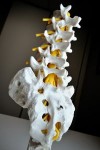Many patients with Ankylosing Spondylitis are relieved when they finally get a diagnosis. Relief, mixed with frustration.
 Usually, Ankylosing Spondylitis sufferers spend many years dealing with doctors, chiropractors, physiotherapists, herbalists, osteopaths, massage therapists, naturopaths, etc. It’s a difficult condition to diagnose as the symptoms can initially be non-specific and the pain episodic.
Usually, Ankylosing Spondylitis sufferers spend many years dealing with doctors, chiropractors, physiotherapists, herbalists, osteopaths, massage therapists, naturopaths, etc. It’s a difficult condition to diagnose as the symptoms can initially be non-specific and the pain episodic.
Hands-on, manual therapy does feel good, but the effect is typically short-lived and the treatment needs to be repeated and repeated. While this can be good for business for some therapists, more often than not, the therapists themselves are frustrated by the lack of long term improvement.
The amount of training on ankylosing spondylitis (and all common rheumatic disease, such as rheumatoid arthritis) is very poor at undergraduate level for physiotherapists. It’s almost non-existent at a postgraduate level. I assume that this sorry state of affairs would be similar in the other allied health fields.
Again, rheumatologists should be doing more to address this.
A physiotherapist I talked to last week remarked that she doesn’t think she has seen many ankylosing spondylitis patients in her career to date. I suggested that she might have missed diagnosing a fair few.
If you don’t actually know what to look for, how are you going to recognise the disease, and importantly, how are you going to treat it correctly?



